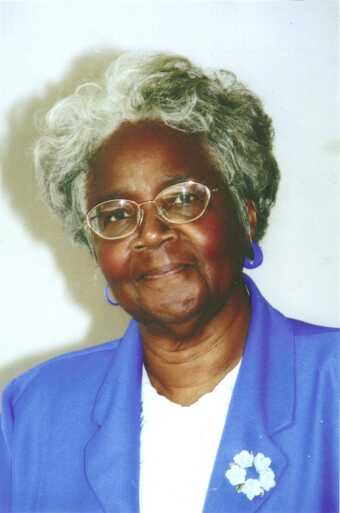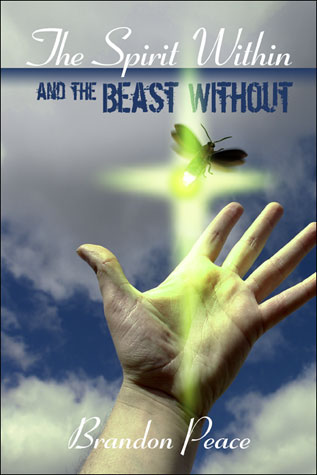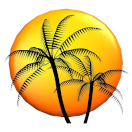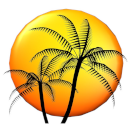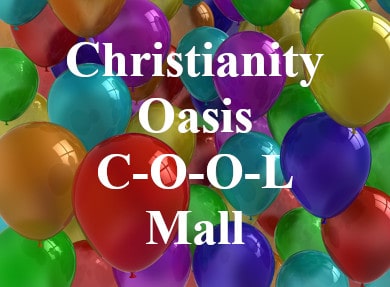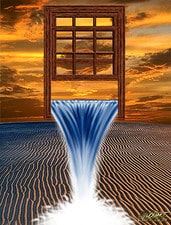Journey to the Holy Land
Pilgrimage to Greece and Turkey
Christianity Oasis has provided this E-book Journey to the Holy Land - Pilgrimage to Greece and Turkey, My Story written by Author Barbara Shaddock Culbreath. We hope you will explore our many studies and programs at Christianity Oasis that look into all aspects of the Christian Walk and reveal truth and bring forth understanding and peace.

Living Water at Christianity Oasis
John 7:38 He that believeth on me, as the scripture hath said,
out of his belly shall flow rivers of living water.
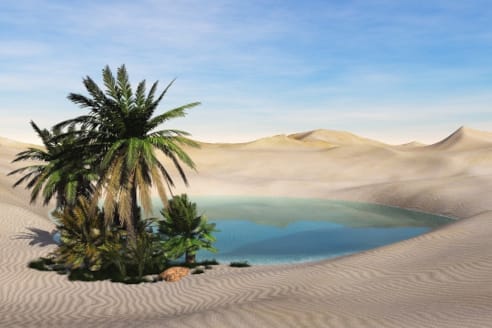
Journey to the Holy Land
Pilgrimage to Greece and Turkey
Welcome to Christianity Oasis Purity Publications. This E-book is titled Journey to the Holy Land - Pilgrimage to Greece and Turkey, My Story written by Author Barbara Shaddock Culbreath. Christianity Oasis in association with Purity Publications proudly presents you with this Pilgrimage to Greece and Turkey E-Book free of charge for your enjoyment.
Click the link below to learn more about the Holy Land:
Early one evening in the year 2000, while relaxing on my sofa, I had fallen asleep, only to be awaken by the ringing of my telephone. When I answered, I heard my girl friend Gertie's voice on the other end. Several years earlier, in 1988, I had traveled with her and her church family on my first trip to the Holy Land.
"Hi Sister Barbara, how are you this evening?"
"I'm blessed and highly favored by The Almighty. How are you Sister Gertie?"
"I'm blessed as well," she responded. "I called to tell you that Prophet James is planning another trip.
This time it will be a Pilgrimage to Greece, Turkey and the Isle of Patmos while following in the footsteps of the Apostle Paul. The trip would also include a cruise on the Aegean Sea.
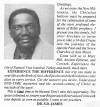
Click on the picture for a larger view.
Would you like to go?"
"Yes, very much, but I'll have to pray about it first. Send me the information so I can see if I can fit it into my budget. As you know I'm retired now as you are. If my spirit is at ease after I pray, I'll go."
"Okay, I'll send you a brochure. However, I can tell you the price now. It will be $2,890.00 for 13 days. There might be a small increase in the port charges, over which Prop, (as he is affectionately called) has no control. Also try to get some of your friends to go. If I can get ten people to go, I will earn a complimentary trip. Otherwise, I probably won't be able to go myself."
"Alright girl friend, I'll talk to you later."
Several days later, I received the brochure. I had been earnestly praying for and answer and I had also discussed it with my family. My family didn't want me to go, they felt it was too dangerous. But, after much prayer, I didn't experience a worried spirit, so, I decided to go.
The following Sunday at church, I saw two church members, Kay and Queen. I told them about the trip. They were both interested. Later, I told some of my other friends about the trip. They claimed they wanted to go. I called Gertie and asked her to send out some brochures to them. After they received the brochures, they all backed out except Kay and Queen. Their explanations were, "The trip may not be safe due to the turmoil in the area." Kay and Queen immediately planned to go an they notified Gertie.
Gertie called me. "Hi Sister Barbara, I am thrilled. I have the ten people, counting the three of you so now I can go."
"I'm glad you are able to go, and we are looking forward to the trip," I answered.
During the ensuing weeks I went to the library to read up on the attractions that were listed in the brochure, but with very little details. I wanted to have a working knowledge of the Biblical sites. This was a practice I had always done when I traveled abroad. I began to prepare myself physically by having a medical check-up and shots, if needed; mentally, by learning as much as I could about the customs and what such a long trip would entail; and spiritually with continued prayer. Never-the-less, this thought kept invading my spirit,
"What if something happened to hinder me from taking the trip as opposed to something happening on the trip?"
I continued to persevere in prayer and shortly after my mind and spirit were settled. I prepared written instructions about my state of affairs for my children and my mom, just in case the Lord called me home.
We were notified that the port charges had indeed increased. The trip would now cost $3,000.00, with everything included except the personal tipping for services. The week before we were to depart, Bishop James arranged for us to gather at his church to receive final instructions and to meet and greet all who were traveling with him.
At the meeting we were given white satin jackets with the logo 'The Year of the Redeemed,' printed in red on the back, which represented the blood of Jesus, and each person's name was printed on the upper left front. Bishop James then briefed us on international laws, the observance of the customs of the people, as well as what kind of clothing we needed to bring.
After he answered a few questions, he stated, "Dear people remember this is a pilgrimage, but I want you to also enjoy the journey. You will be in another country, so respect the people, especially when they serve you. The brochures I issued to you indicate what a fair and proper tip would be. Try to eat what is set before you as much as you can. Some of the mid-easterners can get upset if you leave too much of their food on your plates. Everyone needs to stay with the group. I don't want anyone wandering off alone. Be careful with your personal belongings, especially your passports. We will all meet in New York, but, because we will be coming from different states, it is up to you to make arrangements from your home to JFK Airport. We are scheduled to board the Lufthansa at 9:25 p.m. and everyone needs to stay prayed up."
He dismissed the meeting with prayer and we were served a light collation.
I made arrangements to get to New York alone. Kay and Queen traveled together because they lived near each other and were close friends.
I waited with happy anticipation while I counted the days before departure. They seemed to go by slowly. Two days before we were to leave, I laid my clothes out over my parlor couch and chairs. I checked and doubled checked so that I would not forget anything. I waited until the night before to put my things into my bags.
April 24, 2000
April 24, 2000 had finally arrived. Normally, I would have my children to drive me to the airport, but, I decided this time to go by public transportation. I arose early and got dressed. After a light snack, I left my house at 15 Blue Ledge Drive, at 7:15 a.m. I waited on the corner to catch the MBTA Bus number 34 to get to the Forrest Hills MBTA Station. It came five minutes later. I arrived at the airport and boarded the shuttle to the departure gate at 8:05 a.m. I had to wait for just under two hours at the airport before a Prop plane attendant allowed the passengers to board. Once we boarded, another flight attendant kept shifting people around until there was a balance of weight on the plane before we could lift off at 9:10.
This incident reminded me of a previous time my friend, Virginia and I went to the Bahamas and we had to take a Prop plane from Florida. Our friend MaBelle wouldn't go because she was afraid to fly on the small plane. The ride was extremely bumpy which caused me to become nauseated. I almost had to use the bag that was on the pouch in front of me. I had never gotten sick on a plane before through the many times I had flown. I began to pray, "Heavenly Father please help me to get to the lady's room in case I have to throw up." He answered my prayer. We arrived at JFK at 10:45.
The plane landed a distance from the terminal. We had to carry our bags inside to Terminal B when they were unloaded. This was inconsistent from what I had ever experienced before. Once inside, I had to ask two different people for directions to the terminal because, there were no signs indicating the location of Terminal B. They both gave very snappy answers along with their callous attitudes. I walked to the end of the corridor, and spied the sign pointing to Terminal B way down on the other end. When I reached it, it was a blessing to sit down. I took a motion sickness pill and ate a few dry crackers in hope of settling my stomach.
After about forty-two minutes I felt much better. So, I walked over to the food counter and ordered a Big Mack which I almost never eat at home. The cost was ridiculously over priced, but it did help to finish settling my stomach. I watched different groups arriving throughout the day. I didn't see anyone I knew until late afternoon. I began to wonder if they had steered me to the wrong terminal. Reluctantly, I checked at the desk to be sure. I really didn't want to deal with the New Yorkers' attitudes again. However, the ticket agent was pleasant, and assured me I was in the right place. About an hour later I saw Kay and Queen arrive. I was glad to see them. Then others in our group arrived.
Soon, we were all checked in and ready to board the plane. Before they opened the gate, we were told that there was a hang-up with the connecting plane which caused another group to be late arriving. So, we were not allowed to board the plane until 9:25. We finally lifted off when the late comers arrived. As we boarded and took our seats, we were served orange juice and a snack pack even before every one had boarded.
After we were all settled, the pilot and the flight attendants gave us final instructions. We were served a delicious dinner of beef, rice, broccoli, cheese, shrimps, salad, grapes, raisin bread pudding, rolls and butter, crackers, and a beverage of choice. Shortly afterwards, the attendants collected the containers and lowered the lights for the night. I dozed off at some point.
April 25, 2000
When I awakened the sun was streaming through the windows and the attendants were coming down the aisles serving a continental breakfast of juice, coffee and yogurt. The time was seven hours ahead of USA time. Shortly, we approached the Frankfort, Germany Air Port. The seatbelt lights came on, and the pilot spoke. "We will be landing shortly. Please remain in your seats until the plane stops, and the lights are turned off. There will be someone at the gate to instruct you as to where to board your connecting flight."
We touched down at 10:30 Germany time. We were met by a guide who directed us to our connecting plane to take us to Athens. At 12:25 we boarded, and were on our way. We arrived in Athens Greece at 4:23, which was almost a four hour trip. I was surprised that the airport was so small. We de-planed and were told to wait in a designated area for our next guide, who was there when we arrived at the area. The weather was beautiful with a clear sky and a cool breeze.
Our new guide's name was Victor and our bus driver's name was Sarkis, who drove us to the terminal to retrieve our bags. We were told that we would have to carry our bags most of the time. Once the bags were loaded and we were seated, he gave us a short history of Greece as we meandered through the streets of Athens very slowly.
"Basketball and Track are the two most important Sports in our city," he stated. Then he explained the currency and how to be safe from those who cheat tourists.
We passed the first school that trained the students for sports. High on the hill, off to the right, we could view the Acropolis as we were driven through the very narrow streets. Highway #2, which was the main street that led to the hotel. We arrived safely and checked into the Divanti Palace Acropolis Hotel. Gertie and I were roommates and we went immediately to our rooms to rest. Later, we assembled in the dining room for dinner and were served a delicious dinner of salad, grilled pork (which was exceptional tasty), potatoes, carrots, string beans, rolls, butter, and Almond cake. After we finished eating, but before we left the table, Bishop gave instructions for the next day's journey. Then we retired for the night.
My sleep was very peaceful, but we had to arise early the next morning to stay on schedule.
April 26, 2000
The next morning, we arose, dressed, and gathered in a designated place to wait for the Bishop to arrive to eat breakfast so we could all sit down together. Bishop arrived about ten minutes later and blessed the food. The atmosphere was very pleasant. The breakfast was a buffet, consisting of all kinds of breakfast foods. The juice, coffee, and tea were served by the waiters.
Our bus was waiting outside when we finished breakfast. We boarded the bus and our new guide, Patricia, introduced herself. Our new driver's name was Assis. After we were seated and settled, Patricia began to speak.
"'Hellas," means Greece. Athena is Athens, our capital city. Acropolis means the 'City on the Hill.' You will notice that our streets are very narrow.'"
I noticed how close the buildings were to the narrow streets and appeared to be very antiquated. There were areas where new housing was being constructed. However, the hollow frames looked as though they hadn't been worked on for some time because the iron beams were covered with rust.
Patricia continued to speak, "Athens is the birthplace of Democracy. The people elect 50 representatives and their positions were chosen by lottery. Also Athens was the birthplace of Western Civilization. It was here that many of the philosophical and political geniuses assembled such as: Aristotle, Plato, and Socrates to name a few. Many words we use in the English language such as, museum, democracy, athlete, astronomy, theology, orthodox, colossal, disco and orgy were taken from the Greek language. We could see the merchants closing their shops very early in the day.
Patricia explained, "The people are preparing for Greek Easter by leaving the city to join their families in the villages for the festivities."
As we continued to ride through the city for several blocks, Patricia stated as she pointed, "This is the 5th Century A.D. Church of DAPHNI. It is decorated in Mosaics portraying Jesus Christ and his mother Mary inside. Daphne is named from the Laurel trees. The area ahead is where the Persians were defeated at sea."
As we continued on, I noticed that very few signs were in English, and of course none of us could read the Greek. We finally arrived in Korinth (Corinth). The first place we visited was the Korinth Canal. We alighted from the bus and walked over to the bridge. It was an awesome sight to look down and view the water. This was the first picture I took while standing on the bridge.
Patricia continued to speak.
"This area is called the Pelepones, which is divided into seven Provinces. The Apostle Paul lived here for eighteen months. Over to the right is the 'BEMA,' or the Judgment Seat."
We walked closer to the plaque that was on the wall above the Bema. One of the ministers took a picture of me at the Bema while I touched the edge of the plaque.
Barbara, pointing at the "BEMA"
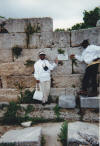
Click on the picture for a larger view.
Bishop then conducted a short service as we gathered around the Judgment Seat.
Group at the "BEMA", Judgment Seat of Paul

Click on the picture for a larger view.
He took his message from Romans 14:5 and Corinthians 9:19, and stated that Paul was a free man, a citizen of Rome, and had all of the rights of the Romans. He finished his message and we continued on to the walled city of Corinth (Korinth) which was in ruins. As we walked through the ruins, we noticed that the heads were chopped off of many of the statues due in part to intentional beheadings, as well as earthquakes, and for souvenirs. Patricia stated, "Once the heads were off the statues, the body would be re-used by simply putting someone else's head on the statue."
We moved on to Mycenae Acropolis. Mycenae is a pre-historic citadel built around 1200 BC, on a vast plain that stretched south to the sea with two gates, the Lion gate and the North gate. The first wall was built around 1350 BC. We visited Atreus' Tomb and other tombs there. I climb three-quarters up to the top and explored a few of them.
Afterward, we went to the Treasure of Atreus, took pictures. We went to another tomb across from the Treasury. The inside of this tomb was different. It was round in shape with a dome at the top that came to a point. The walls were smoky due to the fires that were used at the time of occupation. Patricia explained some history about the tombs.
We were getting tired from so much walking and climbing so most of us were glad to return to the bus.
Soon it was lunch-time. Assis drove us to the 'King Menelads Restaurant.' The owner's name was Demetrius. He welcomed us in as we alighted from the bus and showed us where we were to sit. Each person chose his meal. I ordered stuffed tomatoes, roasted lamb artichoke hearts, moussaka and an orange for dessert. The food was extremely delicious, the best I had eaten at that point.
After lunch we continued on and stopped at a pottery shop where we watched them make several jars, bowls and vases. We then went to a silver shop. We saw how silver was refined. Also the beautiful silver items they crafted. The prices ranged from moderate to expensive. Several people bought some of the jewelry. I didn't buy any jewelry because when I went to the Holy Land several years before, I bought jewelry for my family and friends. So, I decided just to buy a souvenir for them this time.
We returned to the bus and continued on our tour.
We passed several orange and lemon groves. Many of the trees were burdened down with fruit. There were times I was tempted to grab a piece of fruit because they were easy to reach from the bus window because of the narrow streets.
The next city we visited was Epidarus. We didn't alight from the bus. Patricia pointed out the highlights of the city. We arrived back in Athens very late. It had rained while we were on tour. We went to our rooms. There was much confusion when we entered our rooms which were very dark. Most of us went out into the hall trying to figure how to turn the lights on. Finally one of the ministers came and told us we had to use the door key to turn the lights on. We were not told this when we checked in to the hotel, and we found it unusual because we were used to flipping a switch.
Even though it was late, the hotel had prepared dinner for us in the restaurant. The menu was beef, cabbage, carrots, peas and a salad bar. I couldn't eat much because I was still stuffed from Demetrius' restaurant. After dinner we retired for the night. I didn't sleep well most of the night even though the hour was late and I was very tired, because there was too much noise in the room next door. The noise didn't seem to disturb Gertie, because she went to sleep.
April 27, 2000
We arose early, dressed, and assembled in the hotel dining room to wait for Bishop to arrive to bless the food. We were served a delicious buffet breakfast. Shortly afterwards we started on our tour for the day.
Mars Hill, 'Aeropagus' is the Roman name, was the first place we stopped.
The guide stated that the place was also called Arios Pagos, meaning 'from the gods.' Paul preached the famous sermon to the ancient Athenians about the unknown God.
I didn't climb to the top of this hill because of the antiquated steps. I didn't feel comfortable in climbing because you had to climb up backwards in a sitting position. Some of the men climbed to the top. I settled for the picture that I asked one of the saints to take of me with the steps in the background.
Barbara, Mars Hill, on the Acropolis
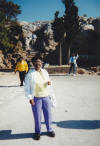
Click on the picture for a larger view.
After those who climbed the hill returned, Bishop stated, "We will have a short service here at the base of the hill. We will start by singing the hymn, 'Power in the Blood.' Minister Teal, will lead us in prayer, then I will speak from Acts 17:18-19."
We returned to the bus and continued on to the Acropolis, the city on the hill. It was a mountain in my view, not a hill. I was proud of myself for climbing to the top. It was a breath-taking view as we panned the land-mass. We saw the Parthenon that had a salient effect among the other structures. It was very hot on the hill. We entered the Poseidon Temple, and the museum. I asked Queen to take a picture of Mars Hill with me in the foreground.
As I walked around taking more pictures, a bee tried to attack me at the Propylaea. As I rushed to get a way, I fell and skinned my knee. I remembered on two previous occasions I was stung by a bee and had an allergic reaction. I had to go to my doctor's office to get shots to heal the swelling. I certainly didn't want to get infected in that country.
We soon boarded the bus to continue the tour. Patricia stated, as she pointed, "This elegant building is the President's Palace." We arrived just in time to see the changing of the guards. It was a very fascinating sight to watch.
She continued talking, "Coming up is the first Olympic Stadium which was built in 1897, when the Olympics were resumed. But, the ancient Olympics started in the Seventh Century, BC, and abolished in the Fourth Century, BC."
Soon we approached the Parthenon which was a large stone edifice. Patricia stated, "The Parthenon was built over 2,500 years ago to house the great statute 'Athena,' goddess of knowledge. Athena means, Virgin Place. Athena was born from the head of Zeus, symbolizing knowledge and wisdom. They used marble from the Pentelicus, a quarry several miles away. It was damaged by stored Turkish gunpowder about 150 years ago. It is against our laws to pick up any of the fragments or pebbles there by."
We moved on and saw the Erechtheion a small temple with a porch of maidens (caryalids) which were women figures made of stone serving as columns. I took a picture of the temple as we were leaving. We then passed the National Gardens, formally called the Royal Gardens. Next we saw the market place, called the 'Agora.' There were many women, but just a few men who appeared to be just hanging around.
Patricia explained, "The Agora was the social and political center. The most important building in the market was the Stoa (Gallery) of Attalos. Now, it is mostly used as a museum."
A short walk down from the Agora is the Byzantine Museum which is famous for the Christian icons and church art. We didn't climb up, but Lycabettos Hill was even higher than the Acropolis and renders a spectacular view of Athens, Piraeus, and the sea.
"The guide stated as she pointed, "That building over there, is the Parliament and the other one is the tomb of the unknown soldiers. That statue there is of Lord Bryon and the other one is Melina Mercouri." The guards were regaled in white blouses, red caps, multi-pleated mislin kilt, black and gold embroidered wool jacket, a band around the calf with a tassel attached, with pomp-pomps on their shoes. They carried a gun held over their left shoulders.
Patricia then stated, "Athens has four economies: agriculture, industry, sea trade and tourism. However, agriculture appears to be declining due to the common market rules. But, olive oil is still the most important economy and we claim that ours' is the best in the world."
We arrived in Thessaloniki which is located in the northern area of Greece. The guide pointed out the magnificent Byzantine Church of Sophia with the finest architectural works of art where the Apostle Paul preached in the fourteenth century. It was nominated as the 8th wonder of the world by many historians. The Christians were well received by the Byzantine church. It is considered the second city of Greece.
Later that evening we returned to the hotel, enjoyed a delicious turkey dinner before retiring for the night.
April 28, 2000
We arose, dressed, ate breakfast, and checked out of the hotel. We left Athens by ship at the Port of Piraeus, which is called MTS World Renaissance, for a three day cruise on the Aegean Sea.
Queen, Barbara, Kay, and Sis Carter on the ship to Mykonos

Click on the picture for a larger view.
Before we left the dock, they mandated that everyone take part in the life safety drill. We had to put on the life jackets that were located in each cabin and meet out on the deck. Some people were slow to obey the request to take part, but, it was made plain that they either put on the jackets and take part or get off the ship.
After the drill, we were free to walk around the ships at our pleasure. Food was very plentiful and everyone could eat at the food court as often as they wanted to. However, the menus were changed for lunch and again for dinner.
We sailed to 'Mykonos.' This was our first stop.
We were given instructions as to what time to be back on board and an identification tag and told that it was our responsibility to get back to the ship or be left, because there would be no guides.
Queen, Kay and I walked around together. We took pictures and stopped in several shops. They bought rings at the Golden Sun Jewelers. I didn't buy anything because I already had many rings. However, the sales man gave me a 'Blue Eye' stone because I was with them. After awhile, we returned to the ship. When we boarded the ship, there was another delicious buffet set up. I saw some dishes that I never seen before. I was not too eager to try food that I had never eaten before. But after a while, I decided that as long as it didn't have snakes or cats in it, I should try some of the foods. So, I tried a dish that had whole baby octopuses mixed in. Actually it was very good.
April 29, 2000
Praise God we arose to a brand new day. However, I had a headache. Never-the-less, I was thankful to be alive with my faculties about me, and enjoying my trip. We arrived in Rhodes at 9:15 am. Shortly after we finished eating breakfast, we gathered in a quiet place and Bishop conducted a short service, which consisted of prayer, songs and a sermon taken from Acts, Chapters 17-21, and he focused on Chapter 12, Verses 1-3.
Our new guide was Ferzan in Turkey, who guided us from this point until the end of our pilgrimage. She stated, "In 55-AD, The Apostle Paul had been North, but then he sailed from Athens to Mykonos and Rhodes. He ministered in Rhodes and picked up supplies there before he sailed to Patira. In mid 90-AD, John Divine sailed the same region so he had those he could contact due to Paul's prior ministry."
We boarded bus #2 and forty-five minutes later we were in Lindos, Rhodes which is part of a string of twelve islands roped along the Turkish coast, on the Aegean Sea. We left the ship and walked awhile. We viewed the forest and could smell the scents of pine and fir trees. In the middle of the city is a medieval town built by the Knights of St. John. Some went to the top of the Rhodes Acropolis. I only went part of the way. We went to the village of Lindos and saw a beautiful church. I don't remember the name.
Most of us had to go to the restroom. The captions over the restrooms were in Turkish, but there was a figure of a woman on one side and a man on the other end. That made it easy to locate the restrooms. A woman was sitting in the entrance way selling small strip of toilet paper because paper was not provided inside of the restrooms. This is how she earned her living. The guide had told us we would be surprised when we went into the restrooms, but she didn't tell us what to expect. So, I thought she was talking about having to pay for toilet paper.
I went into the second stall because Kay entered the first stall. I wondered why that first line was so long. I didn't see a stool, only a hole in the floor with water running. So I thought it was out of order. I got back in line and waited for the next one. When I went in, it was minus a stool as well. Then I was shocked to learn that you were to squat over the hole and relieve yourself. This was unreal to me. I wondered how my friend Kay would be able to squat, because she was on the heavy side. But she was blessed enough to get the first stall that had a standard toilet, the only one in the restroom. From that day on, we all took some toilet paper with us when we left our cabins.
We stopped in some of the shops. I bought my grandson Dylon and I a knee-length tee shirt because I had never seen knee length tee shirts before. I also took pictures of the Acropolis in Rhodes, and bought some post cards with the picture of that beautiful church because they wouldn't allow us to take pictures inside of it. While I was standing outside waiting on the others, a donkey came from behind and butted me. I guess I was in his path. I wasn't hurt but it was an experience, and reminded me of the bee that tried to sting me. Also, I remembered during my first trip to the Holy land, a man grabbed me. I was told that he was demonized, and the area was filled with those who were cursed with demons. Three of the men had to wrestle him down to get him to let go of me.
We re-boarded the bus. A short time later we got off and went into a pottery shop and watched them make vases and hand paint them. We left the shop and walked down the street. Ferzan said, "This is the medieval city where St. John Divine's palace was located, and where the knights lived. Also, where we were walking was a portion of the original street. There were 4000 people who still live here in this ancient walled city."
A short time later we returned to the ship where a special reception and happy hour was prepared for us from 6:00 to 6:30. Afterwards, we assembled into the main dining room for dinner. I selected roast lamb. It was not as tasty as it was at Demetrius' restaurant. They also served baby octopuses.
After dinner, we all retired to our rooms.
April 30, 2000
The next morning we assembled early in the dining room. There was no buffet for breakfast. We docked at 8:30 on the Isle of Patmos and went ashore. It was a rocky island on the Aegean Sea between modern Turkey and Greece, and spread over about 60 square miles. We headed for the cave of Saint John Devine, (also called the 'Revelator'). Saint Ann's church was built directly in front of the cave. So, we went around behind the church to the cave.
We learned that John was not marooned on the island alone as some folks think, because, the island was used as a penal colony by the Romans. Many prisoners were held there and were strongly guarded by the Romans as they were engaged in mining activities. Many Christians were persecuted there during the eighteen months John was thought to have been in exile there, from about AD 94 to 96. He was later released and went back to Ephesus, where he died at approximately the age of 100. He was the only apostle to die a natural death.
Bishop had a short service in front of the cave before we entered. We lit candles in the entrance way. Then we went into the monastery. It was amazingly beautiful. The walls were all wood that was carved in all kinds of designs and pictures. On the way out, I asked Queen to snap a picture of me. She didn't focus well and all she took was part of me and a good snapshot of a strange woman who walked in front of her view. I was very disappointed when I returned home and had the film developed. However, I bought some post cards with different views of the inside of the monastery, because, again we couldn't take pictures.
Later, we arrived in Kusadasi, Turkey. We had to get off of the bus and go through customs. Once we cleared customs, we returned to the bus and Ferzan gave a little history.
She stated, "The population here is 500,000. This area is called 'Asia Minor."'
We departed from the bus again when we reached upper Ephesus. We trekked down a long ancient street. The guide stated,
"This was the 'main' street back in antiquity. Chariots used to come down this road. Notice the columns on each side of the street and that is the statue of Hercules. Over to the left is the Library. "
We took a group picture then, the Bishop conducted a service. He started by singing, 'Nothing but the Blood of Jesus,' followed by 'All the way to Calvary.' He asked one of the ministers to read the scripture, taken from Acts 18:24-28, and Chapter 19:1. He said that Apostle Paul and Apollos visited this area, but St. John was here in a different time period from them. After his message we continued the tour.
We checked into a new hotel named, Hotel Mercure. When we entered our room, I noticed that we had to use the key to turn on the lights again.
May 1, 2000
When I opened my eyes and saw the sunlight streaming through, my first thought was, 'God, you woke me up this morning, and I'm feeling well, thank you God.' I looked out of my window and viewed the Aegean Sea. Our room was on the seafront. I took a picture of the spectacular sight. The hotel was beautiful. The bathroom had a large tub and a tiny one as well. I thought that was very interesting. It reminded me of when I went to Freising, Germany my relatives had two toilet stools in the bathroom facing each other. I thought that was interesting also.
We were told to bring all of our belongings with us because we would not be returning to this hotel. We assembled for breakfast. The food was not very tasty. Bishop gave a few instructions. We then boarded the bus.
The streets were formed from cobble stones, and they were so narrow, the bus could barely make the turns. The bus pulled up to the market place, we alighted and walked through a tunnel to the old city of ancient Smyrna now called 'Izmir.' The city was in ruins and had been abandoned.
Ferzan stated, "The inhabitants left the city because of 'silting' which meant the earth was eroding away and was being deposited into the stream."
We noticed that the women all wore scarves called, 'Hijabs,' on their heads and the men's heads were bare. I had read up on some of the culture, but I didn't remember what was said about the head coverings. So, I asked Ferzan if the hijabs were religious, cultural or both.
She stated very coarsely, "Both."
I felt that she was offended by the question because of her voice tone.
She continued to speak, "Alexander the Great hung around this hill that started from the Acropolis and ended in the market place where we are standing."
We moved on past the train station that the British had built. The first buildings didn't appear to be antiquated as they had in Athens. However, we did pass several shanty areas where the buildings were extremely dilapidated as we moved on.
Just before we approached the aqueducts, the guide stated, "The Turks who lived here were nomads, and they slept on the floor in the early 18th and 19th centuries."
From where we were standing, we could see how the city stretched for miles.
Soon it was time for lunch. We stopped at Anadolin Restaurant. After we were seated, I chose to order, a trout salad, soup and rice pudding. I had to pay $1.50 in American dollars for a bottle of water. After lunch we continued our tour.
Ferzan stated, "Afrudisias is a prelude to Laodicea and goes back to 5000 BC from Aphrodite the Greek Goddess of Love. We walked over to the square across from the museum, and opposite the palace where stood a large stature of a lion in the center. I had a picture of me taken leaning on the statue.
Barbara, Museum on Palace Grounds of Aphrodite

Click on the picture for a larger view.
Ferzan had us wait while she bought tickets for us to enter an enormous stadium. It was oval in shape and completely over grown with weeds.
She said, "At one time this stadium was where the races and javelin tossing, etc, were held and, three thousand people could assemble here. We walked over to the temple of Aphrodite which was also in ruins. The Bishops' palace was connected to the east of Aphrodite's palace. Next we visited an auditorium with a frog pond in front of it. On the side of the wall was a big bug that was very beautiful. I had never seen a two and a half inch long bug before. One of the men was about to squash it when the Bishop told him not to kill it. The bug scurried away. The next stop was the Temple of Artemus which was very huge.
Bishop conducted a short service here. He took his message from Revelation 3:1, the Thyatira Church. He stated, "This church was the end of the churches that were being polluted. They did everything well, including good things in 'works' which included charity, service, and patience, thinking these works could make things happen without faith. But, one problem that was against them, they allowed Jezebel, who called herself a 'prophetess,' to teach and seduce the servants to commit fornication. Never-the-less, they were encouraged to keep living separated and steadfast lives and continue to look for the Savior."
This church was in ruins except for two old walls front and back located on the corner of the street. Even the fallen rocks were gone. However, there was a sign indicating that these ruins were the ancient church.
After the service, a picture of me was taken while I was pointing to the sign.
Barbara, pointing to the sign in the Ruins of Sardis

Click on the picture for a larger view.
Then we stopped at Odun Kofte Restaurant to eat. Afterwards, we re-boarded the bus.
Ferzan continued the tour, and stated, "There was a woman named Lydia, who was a seller of 'purple' and the first convert in the region. However, she was already a believer and worshipped God. She attended to the things that St. Paul preached.
She continued to explain the status of Turkish women. "When the women came from Asia Minor, they had high status. If their husbands passed away, the women became the leaders. This was before Islam. But, after they migrated to lower Iran near the Caspian Sea, they became Moslems. They began to practice their customs. From that point, rules were changed. Marriage could occur at any age, and women had no rights if the husband died. A man could divorce his wife by saying three times, 'I divorce you.' That is why the women always wore their jewelry around their necks, on their arms or their heads because she would have to walk out immediately without taking anything. Also, the man could have as many wives as he wanted. After the Republic, things changed for the better."
We re-boarded the bus and continued on our way. We approached a wreck which blocked the road. Actually this was the second wreck we had seen during our travels. We headed for Pergama.
We arrived and checked into the Alexander Hotel, (Iskender), at 6:00 p.m. After we were settled, we were served dinner at 7:15. Shortly after dinner, we retired to our rooms. There were no radios, televisions or bath tubs. However there was a very nice shower.
May 3, 2000
We arose, dressed and assembled in the dining room where we were served a scanty breakfast of celery, two kinds of cold cuts, boiled eggs, jam, and very strong regular coffee, tea and tang.
After breakfast, we continued on or tour. It was an exceptionally windy, cool and crisp morning. I was glad to have on my satin, 'Year of the Redeemed Jackets,' that the Bishop had asked us to keep with us at all times.
Ferzan stated, "The word 'Pergama' means, 'Church Married to Satan.' The name has been changed to 'Bergamon.' It was founded in the 3rd Century, BC. It was the most powerful kingdom of Western Anatolia during the Hellenistic period. Parchment is thought to have been invented here. The steepest Amphitheater was located in the center of the Acropolis at Pergama. Also the remains of the temple of Athena, and Dionysus were also here. The Altar of Zeus stood at the entrance of the Acropolis but was taken to Berlin's museum. Alexander the Great divided the city into four parts for his friends."
The bus stopped at a point so that those who wanted to could continue to climb up the mountain. I was proud of myself because I climbed to the top of the Acropolis. We went onto the Red Hall. The guide stated, "It is called Red Hall because it was constructed from red bricks. It is the Egyptian Goddess Isis and others' Bacillica in about 500-1000 AD which brings us to the Dark Ages as for as religion goes. And, the printing press opened the door to the gospel."
We shopped before we left Bergamon at 11:30. I bought another hat and an elephant. On the way we saw the third accident. We couldn't tell how serious it was because the bus driver didn't stop, but went around the wreck.
Our next stop was Esenler Restaurant for lunch. The waiters brought out trays of food to show us what foods from which we could choose. I guess it was their practice because many of the visitors couldn't read the menu, so it was easier to choose from sight. After we finished we returned to the bus. We rode three hours to the next destination which was Troas (Troy.) I along with others dozed off.
Ferzan continued to explain the sights. Those of us who were asleep missed some of the information. But, I woke up just in time to see the breath-taking white cliffs and what looked liked carefully shaped basins of water that caught the water that drips down. The scientist says the hot springs, flowing down rapidly, loses heat, which makes the waterfalls look like snow or cotton. When looking afar, the plains looked like covered pools.
As we rode through Pamukkale, Ferzan stated, "The city is located in the inner Aegean region near Denzli in Turkey. The limestone layers in the pool form steps, one above the other. So, the continual flow of water produces the phenomenal effect. It was said to be nominated as the 8th wonder of the world by the historians."
After awhile, we came to another area. The guide, stated," According to Acts 15:8 and Acts 20:12-16, we passed the dock where St. Paul boarded the boat that took him to Macedonia.
A few blocks up the road we reached Dylan and saw the ruins of some of the Roman Baths. Two men got off the bus and walked up the hill to get a better look. Everyone else stayed on the bus. When they returned, the driver drove us to the city of Canakkale, Turkey. We stopped at some of the shops before we checked into the Akol Hotel, on the water front. Some of them bought rugs. I didn't buy anything because I had enough small souvenirs to try to bring home. When we arrived back at the hotel, we ate and I went to my room to relax. Gertie visited the rooms of some of the other friends of hers. Somehow, I was exhausted each night, so I rarely went from room to room to visit.
May 4, 2000
We were scheduled to spend the full day in Troy. Therefore, we made an early departure from the hotel to the ancient city. This is where the legendary Trojan horse story took place according to the Illiad's of Homer.
Ferzan stated very emphatically. "The historical account of the people of Troy is wrong, and the people were not so stupid that they would allow a wooden horse filled with Greeks to sneak upon them and seize the city. Troy's history is buried in myths and mud. Nine levels of the fable cities have been found. This fable supposedly happened at the sixth level of uncovered cities. Also, Achillis was shot in the foot and he died. That is where we get the term, "Achillis Heel" in medicine.
Pictures were taken of the horse.
Barbara, Trojan Horse in background
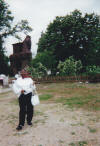
Click on the picture for a larger view.
We boarded the ferry to Geliobu, Turkey. It took a half hour to reach our destination. On our arrival we enjoyed a delicious fish dinner, with a mixture of Spinach, rice onions, small pieces of fresh tomatoes that had been sautéed in olive oil.
Our next stop was the Turkish market. I bought two kinds of cookies for less than one US dollar. They were very delicious. I shared them with those on the bus.
Ferzan wanted us to taste their popular candy, called 'Turkish Delight' made out of buffalo cream, marshmallows and nuts. It was very tasty, but too sweet for me. I was quite surprised because in my opinion, she was not over friendly. She may have been a bit irritated because she had told everyone not to pick up any of the rocks and broken marble because, it was against the law. Also, the country planned to restore as many of the ruins as possible. Yet, she saw someone pick up some of the stones. She was very knowledgeable of the country's history and customs. She mentioned at one point that she had lived in the United States for eight years and gone to college as well.
We returned to the bus. Our next stop would be Hierapolis, Istanbul.
Ferzan continued to explain the history and said, "The city is located between two Continents. The country was formerly known as Constantinople. The population is 13 million and is the largest city in Turkey and most of Europe. The crime rate is very high and there are a lot of drugs and homeless children. There are 450 Mosques. Also, Hagia St. Sophia Church is located here. It was built by the Emperor Justinian, in (532-535.) There are 107 columns, fossil embedded white marble, and beautiful mosaics. The name means in Turkey, 'The Church of Divine Wisdom.' Also, it was the largest church in Christendom for 1000 years. There was The Great Plague in 541-543 caused by rats in the fifteenth year of Justinian's reign. The plague was renamed, The Black Death.
Constantinople was named 'Byzantine' when Constantine transferred the capital of the empire from Rome." We arrived in Istanbul at 5:00 Turkish time.
As we rode through the city, downtown Istanbul looked a little more cosmopolitan to me than some of the other cities we had visited. There were many regular shops especially, leather shops. However, some areas were antiquated to a point.
We finally arrived and checked in at the Presidential Hotel, which was located on the English side. It was very elegant inside. There was a golden three feet planter in the corridor that had been polished to the hilt. After we all settled in our rooms, we assembled in the dining hall for a delicious dinner of stuffed Zucchini squash with rice, onions and melted cheese on top. After dinner, some stayed and talked, but I retired to my room for some much needed rest.
May 5, 2000
The next morning we arose once again to get started for our daily tour. We were served the best breakfast that I had eaten since we left the ship in Greece. We boarded the bus and were seated. Our site seeing tour began.
Ferzan stated as we rode along, "That building is the University of Istanbul. Soon we will pass under the big Aqueduct and the Spice market. Over to the left is where the Orient Express used to come to Hippodrome square. The Hippodrome was built by the people of Constantinople on the coast of the Black Sea. In the fourth century, it was the former center for the sports, including the chariots races and political activities. The Obelisk from Egypt and the Serpentine column from Delphi could be seen.
We alighted from the bus and crossed the street to the Blue Mosque.
Barbara, in the foreground, steps of Blue Mosque

Click on the picture for a larger view.
It was a spectacular site from the outside. To enter we had to take off our shoes. There was a plastic bag to contain them and they were carried to the other side so we could retrieve them when we departed the Mosque.
The infrastructure was extremely beautiful. There were rectangular squares on the carpet where the worshippers knelt to pray. There were beautiful stained glass windows on all three levels throughout the Mosque. The Cupolo (dome) also had stained glass windows around the base of it. I really can't explain the beauty of the structure, but it was magnificent and spotless.
We then walked over to St. Sophia, The Church of Divine Wisdom. We climbed the long winding stairs to the ramp to the dome base. It was very difficult to climb, but very interesting and well worth viewing the site. Part of it was under restoration.
When we went outside, a group of children came over to me. They were very friendly, and they spoke English. They seemed to be quite fascinated then asked me if I was an American. I said yes, so they wanted to take a picture with me. I called one of the men over to snap the picture and several others came over, so he took a group picture.
Part of group and children, across from the Blue Mosque

Click on the picture for a larger view.
We continued on. Ferzan stated, "Over there are three separate court yards. Soon you will view the Crowned Prince's garden called, 'Golden Road. Following that we will visit the Queen Mother's chambers, the Harem of the Concubines and the sultan's chambers, and the Treasury of Gold and Precious Stones.
The last most magnificent site we visited was the Topkapi Palace. There the Throne of Sultan Amed, was enshrined behind what appeared to be glass. (1603-1617) The splendor of it was breath-taking as I looked at the Diamonds, Rubies, and other precious stones that covered it. I had never seen a real throne before. I had a picture taken of me as close to the glass enclosure as I could get.
Barbara, at Sultan Amed's Throne, Topkapi-Palace
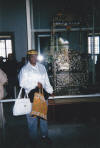
Click on the picture for a larger view.
The last place we visited was the gigantic Bazaar Center. It appeared to cover a four-block square outside, and inside was a maze of mini-streets with the names at the beginning. If you didn't pay attention, you could easily get lost. Everything imaginable was displayed there. It was very tempting to purchase the merchandise, because the items were so cheap. The problem was to get them to the States. So, I settled for buying my daughter a Turkish doll to go in her doll collection. I had bought other souvenirs for my boys and family members. Many of them bought shoes and bags from the leather shops.
We boarded. This was the most exhausting day of all. I was completely worn out by the time we arrived at the hotel. We said farewell to Ferzan, and went into the hotel.
Bishop instructed everyone to pack their things and rest before assembling in the dining room for our final meal, instructions, and message on the Pilgrimage. He also asked everyone to dress in their best attire for dinner.
Kay, Queen and I, came down early so we could walk around to see the beautiful hotel's interior. I was fascinated by the beautiful golden planter we had seen on our arrival but, I never took the time to walk over to get a closer view. We took each other's picture standing beside it.
Soon, the Bishop came down, and we all assembled in the dining room. The Bishop began his message by summarizing our ten day journey.
I had taken notes all during the Pilgrimage. Therefore, I only took notes on the new information. He stated, "The Crusaders were Europeans in the 11th and 12th Centuries trying to recover the Holy Land from the Muslims. Saladen, Sultan of Egypt and Syria was the Muslims leader. Pope of Urban II, launched the first Crusade.
There were five centuries of Holy Wars:
- 1095-1096, the Peasant's Crusade
- 1147-1149, the Second Crusade
- 1189-1192, the Third
- 1202-1204, the Fourth Crusade, Children's Crusade
- 1218-1221, the Fifth Crusade
- 1228-1229, the Sixth Crusade
- 1248-1254, the Seventh Crusade
He concluded by saying, "We are scheduled to catch the 6:00 am, flight to Frankfort, Germany. All bags should be outside your door no later than 2:30 am for pickup."
A delicious dinner was served. Some sat around and talked, and some went to their rooms to pack and retire for the night.
Kay, Barbara, and Queen, last night celebration

Click on the picture for a larger view.
We arose at 1:45 am, and put our bags out for pick-up. We later gathered for breakfast. Bishop started with a short prayer and individual Testimony service. Several people rose and testified about how thankful they were to be blessed to make the pilgrimage and thanked the Bishop for planning the trip. After each person had their chance to testify, Bishop James arose and said, "I thank everyone for travelling with us, and if there were any mistakes, take them all in love. He said a final prayer. We then left for the airport for our flight to New York.
For what seemed like forever, we finally reached Kennedy Airport. Here, we all said farewell to each other. Then, we went to the different gates to wait for the flights that would take us to our different homes. Once we arrived at Kennedy Airport, I had to wait alone almost all day for my flight to Boston at 5:30 pm. USA time. Gertie and Kay were scheduled on an earlier flight to Boston.
But, to God be the Glory for the good things He has done. I arrived home safe.
This was the most inspiring trip, second only to my two trips to the Holy Land, the first time on 1988, and the second time in 1993.
Note: I was not able to take pictures of all of the sites I visited, but I bought as many post card pictures as I could.
Dr S. D. James (Bishop), on the Mountain in Corinth

Click on the picture for a larger view.
Group taking notes

Click on the picture for a larger view.
Click the link below to return to
Purity Publications Free Christian Ebook Store:
Copyright © 2000-2025 All rights reserved.
Learn how the Christianity Oasis Ministry was created by the Hand of the Lord. A true story of unconditional Love, Mercy and God's glorious Grace.
Excellent Christian Resources
Holy Spirit ... This is one of the most awesome gifts you will ever receive or share.
When you have finished this Pilgrimage to Greece and Turkey free E-book, you can also check out some of the other Christian entertainment, games, music, books, mall, studies and programs within our Christian community below:
